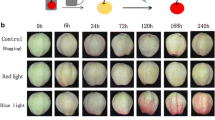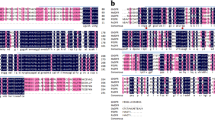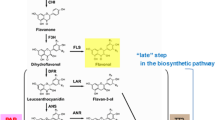Abstract
The number of different anthocyanin molecules potentially produced by Arabidopsis thaliana and which anthocyanin molecule is the first product of anthocyanidin modification remain unknown. To accelerate the understanding of these questions, we investigated anthocyanin biosynthesis in rosette leaves of both pap1-D and wild-type (WT) A. thaliana plants grown in nine growth conditions, which were composed of three light intensities (low light, middle light, and high light) and three media derived from MS medium (medium-1, 2, and 3). These nine growth conditions differentially affected the levels of anthocyanins and pigmentation patterns of rosette leaves, which were closely related to the diversification levels of cyanin structures. The combined growth conditions of high light and either medium-2 or medium-1 induced the most molecular diversity of anthocyanin structures in rosette leaves of pap1-D plants. Twenty cyanin molecules, including five that were previously unknown, were characterized by HPLC-ESI-MS and HPLC-TOF-MS analyses. We detected that the A. thaliana anthocyanin molecule A11 was most likely the first cyanin derived from the multiple modification steps of cyanidin. In addition, in the same growth condition, rosette leaves of pap1-D plants produced much higher levels and more diverse molecular profiling of cyanins than those of WT plants. The transcript levels of PAP1, PAL1, CHS, DFR, and ANS cDNAs were much higher in pap1-D rosette leaves than in WT ones. Furthermore, on the same agar-solidified medium, an enhancement of light intensity increased levels and molecular diversity of cyanins in both pap1-D and WT rosette leaves. In the same light intensity condition, the responses of anthocyanin levels and profiling to medium alternation were different between pap1-D and WT plants.







Similar content being viewed by others
Abbreviations
- pap1-D:
-
Production of anthocyanin pigmentation1-Dominant
- PAP1:
-
Production of anthocyanin pigmentation1
- HPLC-ESI-MS:
-
High performance-electrospray ionization-mass spectrometry
- HPLC-TOF-MS:
-
High performance-time of flight-mass spectrometry
- RT-PCR:
-
Reverse transcription-polymerase chain reaction
References
Ang LH, Deng XW (1994) Regulatory hierarchy of photomorphogenic loci: Allele-specific and light-dependent interaction between the HY5 and COP1 loci. Plant Cell 6:613–628
Bloor SJ, Abrahams S (2002) The structure of the major anthocyanin in Arabidopsis thaliana. Phytochemistry 59:343–346
Borevitz JO, Xia Y, Blount J, Dixon RA, Lamb C (2000) Activation tagging identifies a conserved MYB regulator of phenylpropanoid biosynthesis. Plant Cell 12:2383–2394
Cominelli E, Gusmaroli G, Allegra D, Galbiati M, Wade HK, Jenkins GI, Tonelli C (2008) Expression analysis of anthocyanin regulatory genes in response to different light qualities in Arabidopsis thaliana. J Plant Physiol 165:886–894
Dixon RA, Xie DY, Sharma SB (2005) Proanthocyanidins—a final frontier in flavonoid research? New Phytol 165:9–28
Feyissa D, Løvdal T, Olsen K, Slimestad R, Lillo C (2009) The endogenous GL3, but not EGL3, gene is necessary for anthocyanin accumulation as induced by nitrogen depletion in Arabidopsis rosette stage leaves. Planta 230:747–754
Galway ME, Masucci JD, Lloyd AM, Walbot V, Davis RW, Schiefelbein JW (1994) The TTG1 gene is required to specify epidermal cell fate and cell patterning in the Arabidopsis root. Develop Biol 166:740–754
Gao P, Xin Z, Zheng Z-L (2008) The OSU1/QUA2/TSD2-encoded putative methyltransferase Is a critical modulator of carbon and nitrogen nutrient balance response in Arabidopsis. PLoS ONE 3:e1387
Gonzalez A, Zhao M, Leavitt JM, Lloyd AM (2008) Regulation of the anthocyanin biosynthetic pathway by the TTG1/bHLH/Myb transcriptional complex in Arabidopsis seedlings. Plant J 53:814–827
Grotewold E (2006) The genetics and biochemistry of floral pigments. Ann Rev Plant Biol 57:761–780
Holton TA, Cornish EC (1995) Genetics and biochemistry of anthocyanin biosynthesis. Plant Cell 7:1071–1083
Kim J, Yi H, Choi G, Shin B, Song P-S, Choi G (2003) Functional characterization of phytochrome interacting factor 3 in phytochrome-mediated light signal transduction. Plant Cell 15:2399–2407
Koornneef M (1981) The complex syndrome of ttg mutants. Arabidopsis Inf Serv 18:45–51
Kubasek WL, Shirley BW, McKillop A, Goodman HM, Briggs W, Ausubel FM (1992) Regulation of flavonoid biosynthetic genes in germinating Arabidopsis seedlings. Plant Cell 4:1229–1236
Kubo H, Peeters AJM, Aarts MGM, Pereira A, Korneef M (1999) ANTHOCYANINLESS2, a homeobox gene affecting anthocyanin distribution and root development in Arabidopsis. Plant Cell 11:1217–1226
Lea U, Slimestad R, Smedvig P, Lillo C (2007) Nitrogen deficiency enhances expression of specific MYB and bHLH transcription factors and accumulation of end products in the flavonoid pathway. Planta 225:1245–1253
Lepiniec L, Debeaujon I, Routaboul J-M, Baudry A, Pourcel L, Nesi N, Caboche M (2006) Genetics and biochemistry of seed flavonoids. Ann Rev Plant Biol 57:405–430
Lillo C, Lea US, Ruoff P (2008) Nutrient depletion as a key factor for manipulating gene expression and product formation in different branches of the flavonoid pathway. Plant Cell Environ 31:587–601
Lloyd AM, walbot V, Davis RW (1992) Arabidopsis and Nicotiana anthocyanin production activated by maize regulators R and C1. Science 258:1773–1775
Luo J, Nishiyama Y, Fuell C, Taguchi G, Elliott K, Hill L, Tanaka Y, Kitayama M, Yamazaki M, Bailey P, Parr A, Michael AJ, Saito K, Martin C (2007) Convergent evolution in the BAHD family of acyl transferases: identification and characterization of anthocyanin acyl transferases from Arabidopsis thaliana. Plant J 50:678–695
Martin T, Oswald O, Graham IA (2002) Arabidopsis seedling growth, storage lipid mobilization, and photosynthetic gene expression are regulated by carbon:nitrogen availability. Plant Physiol 128:472–481
Meyer P, Heidmann I, Forkmann G, Saedler H (1987) A new petunia flower colour generated by transformation of a mutant with a maize gene. Nature 330:677–678
Misson J, Raghothama KG, Jain A, Jouhet J, Block MA, Bligny R, Ortet P, Creff A, Somerville S, Rolland N, Doumas P, Nacry P, Herrerra-Estrella L, Nussaume L, Thibaud M-C (2005) A genome-wide transcriptional analysis using Arabidopsis thaliana Affymetrix gene chips determined plant responses to phosphate deprivation. PNAS 102:11934–11939
Morcuende R, Bari R, Gibon Y, Zheng W, Pant BD, Blasing O, Usadel B, Czechowski T, Udvardi MK, Stitt M, Scheible W-R (2007) Genome-wide reprogramming of metabolism and regulatory networks of Arabidopsis in response to phosphorus. Plant, Cell Environ 30:85–112
Muller R, Morant M, Jarmer H, Nilsson L, Nielsen TH (2007) Genome-wide analysis of the Arabidopsis leaf transcriptome reveals interaction of phosphate and sugar metabolism. Plant Physiol 143:156–171
Murashige T, Skoog F (1962) A revised medium for rapid growth and bioassays with tobacco tissue culture. Physiol Plant 15:473–497
Nakabayashi R, Kusano M, Kobayashi M, Tohge T, Yonekura-Sakakibara K, Kogure N, Yamazaki M, Kitajima M, Saito K, Takayama H (2009) Metabolomics-oriented isolation and structure elucidation of 37 compounds including two anthocyanins from Arabidopsis thaliana. Phytochemistry 70:1017–1029
Ni M, Tepperman JM, Quail PH (1998) PIF3, a phytochrome-interacting factor necessary for normal photoinduced signal transduction, is a novel basic helix–loop–helix protein. Cell 95:657–667
Olsen KM, Lea US, Slimestad R, Verheul M, Lillo C (2008) Differential expression of four Arabidopsis PAL genes; PAL1 and PAL2 have functional specialization in abiotic environmental-triggered flavonoid synthesis. J Plant Physiol 165:1491–1499
Pourcel L, Irani NG, Lu Y, Riedl K, Schwartz S, Grotewold E (2009) The Formation of anthocyanic vacuolar inclusions in Arabidopsis thaliana and implications for the sequestration of anthocyanin pigments. Mol Plant: ssp071
Ramsay NA, Glover BJ (2005) MYB-bHLH-WD40 protein complex and the evolution of cellular diversity. Trends Plant Sci 10:63–70
Rowan DD, Cao M, Kui L-W, Cooney JM, Jensen DJ, Austin PT, Hunt MB, Norling C, Hellens RP, Schaffer RJ, Allan AC (2009) Environmental regulation of leaf colour in red 35S:PAP1 Arabidopsis thaliana. New Phytol 182:102–115
Rubin G, Tohge T, Matsuda F, Saito K, Scheible W-R (2009) Members of the LBD family of transcription factors repress anthocyanin synthesis and affect additional nitrogen responses in Arabidopsis. Plant Cell 21:3567–3584
Shan X, Zhang Y, Peng W, Wang Z, Xie D (2009) Molecular mechanism for jasmonate-induction of anthocyanin accumulation in Arabidopsis. J Exp Bot erp223
Shin J, Park E, Choi G (2007) PIF3 regulates anthocyanin biosynthesis in an HY5-dependent manner with both factors directly binding anthocyanin biosynthetic gene promoters in Arabidopsis. Plant J 49:981–994
Solfanelli C, Poggi A, Loreti E, Alpi A, Perata P (2006) Sucrose-specific induction of the anthocyanin biosynthetic pathway in Arabidopsis. Plant Physiol 140:637–646
Song YH, Yoo CM, Hong AP, Kim SH, Jeong HJ, Shin SY, Kim HJ, Yun D-J, Lim CO, Bahk JD, Lee SY, Nagao RT, Key JL, Hong JC (2008) DNA-binding study identifies C-box and hybrid C/G-box or C/A-box motifs as high-affinity binding sites for STF1 and LONG HYPOCOTYL5 proteins. Plant Physiol 146:1862–1877
Springob K, Nakajima H, Yamazaki M, Saito K (2003) Recent advances in the biosynthesis and accumulation of anthocyanins. Nat Prod Rep 20:288–303
Teng S, Keurentjes J, Bentsink L, Koornneef M, Smeekens S (2005) Sucrose-specific induction of anthocyanin biosynthesis in Arabidopsis requires the MYB75/PAP1 gene. Plant Physiol 139:1840–1852
Tohge T, Nishiyama Y, Hirai MY, Yano M, Nakajima J, Awazuhara M, Inoue E, Takahashi H, Goodenowe DB, Kitayama M, Noji M, Yamazaki M, Saito K (2005) Functional genomics by integrated analysis of metabolome and transcriptome of Arabidopsis plants over-expressing an MYB transcription factor. Plant J 42:218–235
Walker AR, Davison PA, Bolognesi-Winfield AC, James CM, Srinivasdan N, Blundell TL, Esch JJ, Marks MD, Gray JC (1999) The TRANSPARENT TESTA GLABRA 1 locus, which regulates trichome differentiation and anthocyanin biosynthesis in Arabidopsis, encodes a WD40 repeat protein. Plant Cell 11:1349–1377
Winkel-Shirley B (2001) Flavonoid Biosynthesis. A colorful model for genetics, biochemistry, cell biology, and biotechnology. Plant Physiol 126:485–493
Xie D-Y, Jackson LA, Cooper JD, Ferreira D, Paiva NL (2004) Molecular and biochemical analysis of two cDNA clones encoding dihydroflavonol-4-reductase from Medicago truncatula. Plant Physiol 134:979–994
Xie D-Y, Sharma SB, Wright E, Wang Z-Y, Dixon RA (2006) Metabolic engineering of proanthocyanidins through co-expression of anthocyanidin reductase and the PAP1 MYB transcription factor. Plant J 45:895–907
Zhang F, Gonzalez A, Zhao M, Payne CT, Lloyd A (2003) A network of redundant bHLH proteins functions in all TTG1-dependent pathways of Arabidopsis. Development 130:4859–4869
Zhou L-L, Zeng H-N, Shi M-Z, Xie D-Y (2008) Development of tobacco callus cultures over expressing Arabidopsis PAP1/MYB75 transcription factor and characterization of anthocyanin biosynthesis. Planta 229:37–51
Zuluaga DL, Gonzali S, Loreti E, Pucciariello C, Degl’Innocenti ED, Guidi L, Alpi A, Perata P (2008) Arabidopsis thaliana MYB75/PAP1 transcription factor induces anthocyanin production in transgenic tomato plants. Funct Plant Biol 35:606–618
Acknowledgments
This work was financially supported by North Carolina State University and USDA-NRI grant (USDA 2006-35318-17431). We thank Dr. LiLi Zhou for help running samples for LC–MS analysis. We thank Dr. Wendy Boss from our department for her critical reading of this manuscript and her many suggestions.
Author information
Authors and Affiliations
Corresponding author
Electronic supplementary material
Below is the link to the electronic supplementary material.
425_2010_1142_MOESM1_ESM.jpg
S-Fig. 1 Normalized values from semi-quantitative analysis of RT-PCR products show expression levels of 5 genes in rosette leaves of plants grown in different growth conditions. a: Normalized values show the impacts of three light intensities on transcript levels of five genes in rosette leaves of both WT and pap1-D plants grown on agar-solidified medium-2. Due to poor growth of WT plants in the condition of HLM-2, total RNA isolated from plants grown in the condition of HLM-3 were used as controls. HLM-2 (WT:M-3) means that total RNA for pap1-D plants was isolated from leaves on the condition of HLM-2 and total RNA for WT plants was isolated from leaves on the condition of HLM-3. b: Normalized values show the impacts of three media on transcript levels of 5 genes in rosette leaves of both WT and pap1-D plants grown in the ML condition. RT-PCR analysis for WT seedlings grown on medium-3 in the ML condition is not shown due to low yield and poor quality of total RNA from rosette leaves. LLM-2: low light: 50 μmol m−2 s−1 of light intensity and medium-2: ½ strength of NH4NO3 and KNO3 in MS medium MLM-2: middle light: 200 μmol m−2 s−1 of light intensity and medium-2 HLM-2: high light: 500 μmol m−2 s−1 of light intensity and medium-2 HLM-3: high light and medium-3: 0 NH4NO3 and ½ strength of KNO3 in MS medium MLM-1: middle light and medium-1: full strength of basal MS medium MLM-3: middle light and medium-3 (JPEG 942 kb)
425_2010_1142_MOESM2_ESM.jpg
S-Fig. 2 Mass spectra of 20 cyanins detected at 530 nm from rosette leaves of 20-day-old pap1-D plants grown in the condition of HLM-2 (high light: 500 μmol m−2 s−1 of light intensity and medium-2: ½ strength of both NH4NO3 and KNO3 in MS medium) (JPEG 2248 kb)
Rights and permissions
About this article
Cite this article
Shi, MZ., Xie, DY. Features of anthocyanin biosynthesis in pap1-D and wild-type Arabidopsis thaliana plants grown in different light intensity and culture media conditions. Planta 231, 1385–1400 (2010). https://doi.org/10.1007/s00425-010-1142-9
Received:
Accepted:
Published:
Issue Date:
DOI: https://doi.org/10.1007/s00425-010-1142-9




